Trends in curtain decoration
Second installment of the week on keys to decorating curtains! Once the hanging and fastening system has been decided, it is time to deal with another fundamental aspect: to define its aesthetics, adapting it to the trends of the moment.

And yes, although it may not seem like it, in curtains there are also fashions, so today we will explore the current trends in this field to be the latest. Here we go!
Neutral Curtains
Gone are the days of curtains with variegated prints or bright colors. In reality, the trend is for the curtains to go somehow unnoticed, dressing the room but passing all the attention to the furniture. Smooth textures and soft colors (white, ecru, light gray or beige) would fall into this option.
Neutral curtains visually balance the decoration. They bring light, lightness and serenity to the room and adapt to any style. For a greater sense of peace, choose them in the same tone as the walls, they will welcome the space without standing out from the rest of the room.


Degraded Curtains
We have already seen in a previous post how the gradient tones, both in paint and in furniture and accessories, are very current.
Applied to curtains, the gradient brings a fresher, bohemian and artisan air, adding a point of originality to any room.
They also work well in contemporary settings with a wealth of accessories and you can even stain them yourself, following one of the thousands of tutorials found in the DIY philosophy.

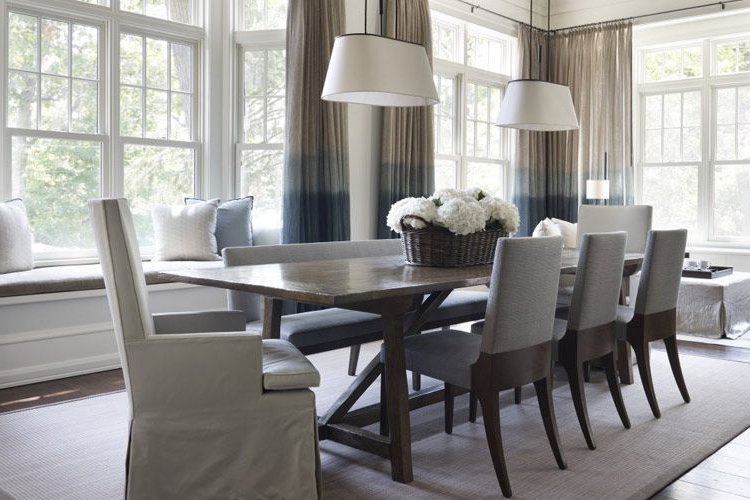
Bicolor Curtains
The gradient curtains bring a subtle touch of color to the decoration of the environment, but if you are looking for something stronger, the bicolor curtains are your best option. This trend is characterized by the contrast of tones between them, either two opposite and intense colors or a strong color in the lower strip on a curtain in a bright color.
In bicolor curtains we can find two options:
a) Bass contrast
This option puts the focus of the contrast in the lower area of the curtain. In these cases the ideal is to use the lighter color at the top and the darker color at the bottom.
For those who have high ceilings, it also has the advantage of being able to join two different fabrics in the same curtain to make it longer, since often in the market there are no fabrics longer than 3 meters.


b) Contrast in the perimeter
This very elegant option consists of creating a perimeter band in a very contrasting tone. The most common is to do it in black and white and it looks perfect in environments with a renewed classic style.


Dark Curtains
They work especially well in bright spaces using the same color chosen in them in some other piece of furniture or complement, bringing character to the room.
They are also used in the decoration of spaces in dark colors where a monochromatic decoration is sought, a contemporary trend on the rise.

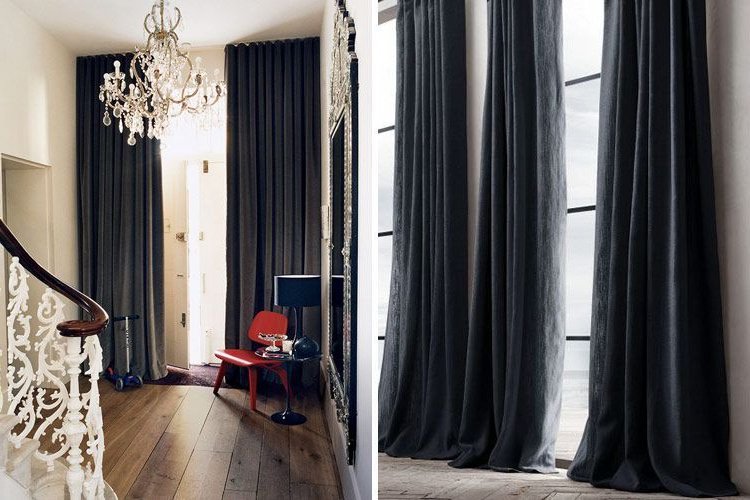
Velvet Curtains
A sophisticated material such as velvet gives a different and personal touch. We are used to seeing it in the upholstery of chairs and sofas, but it is less frequent when decorating with curtains, more associated with palatial homes or classic interiors.
However, combined with moderation and in neutral spaces, they provide a very interesting touch of visual contrast.


Curtains + Sheers
A classic that never fails is to combine a curtain and a net curtain in correlative tones of the same range. The ideal is to use the strongest color or print in the curtain and its softer version in the net curtain to bring light to the whole.


Curtains + Blind
Following the previous trend that combines curtains with net curtains, there is a more contemporary alternative: replacing the net curtain with one or more blinds.
This option brings a touch of modernity to any environment and has the advantage of hiding the box of the blind very effectively, freeing us from the old "bandeaux" (bandeaux in French) that covered the upper area with the same fabric of the curtain.
Although all types of blinds can be used, the most common is to combine a roller blind with a smooth texture and tone with light curtains with some fall.


Flush or trawl?
Where do I cut? This is one of the most common questions when decorating with curtains, and the answer is that either of the two trends are valid!
The choice will depend rather on the style you want to give to an environment or its practicality: The curtains flush with the floor are more suitable for modern and informal environments of contemporary style (besides being much more practical when cleaning the floor ;-)). However, if you want to get a classic and elegant air, you should definitely let your curtain drag about 20cm on the floor, even at the risk of being damaged by friction.
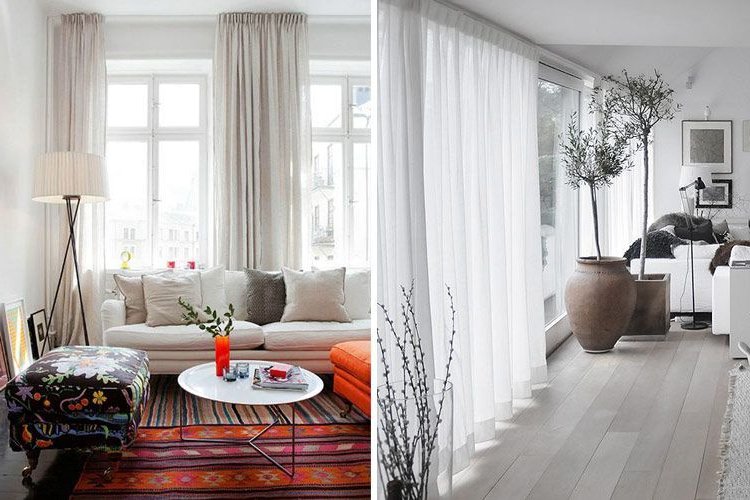
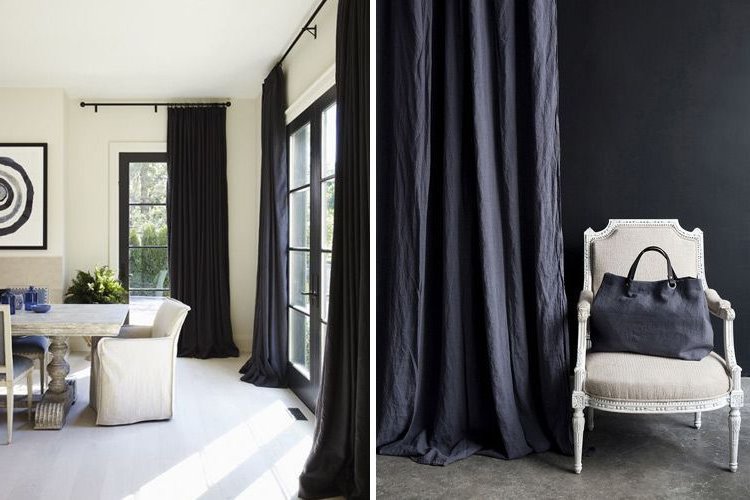
The height, to ceiling (or almost)
High and stylized curtains are in. In this sense, a very common mistake in houses with high ceilings is to hang the curtain rod just above the window, leaving a piece of wall view to reach the ceiling. Error!!!... If the ceiling allows you, place the rod almost at the limit to give a more stately look.
Only if your ceiling has perimeter moldings you should place the bar about 10-15cm from its termination depending on the height, but in any case avoid placing them flush with the window as the room will lose character.
Of course, if we talk about rails, it is a different matter, as these are by definition anchored to the ceiling ;-).


Draped Curtains
For interiors with a certain classic touch, draped curtains or curtains made of fabrics with a certain elegance, such as organza, wild silks or any fabric that does not have a perfect drape, but is somewhat slightly wrinkled, are also perfect.

Tassel curtains
For those who prefer an informal style, curtains with tassels are very fashionable. Although they can be used in different colors, the ones that look best are the ones in the same color as the curtain, so they don't look too childish. However, variety is the spice of life ;-)
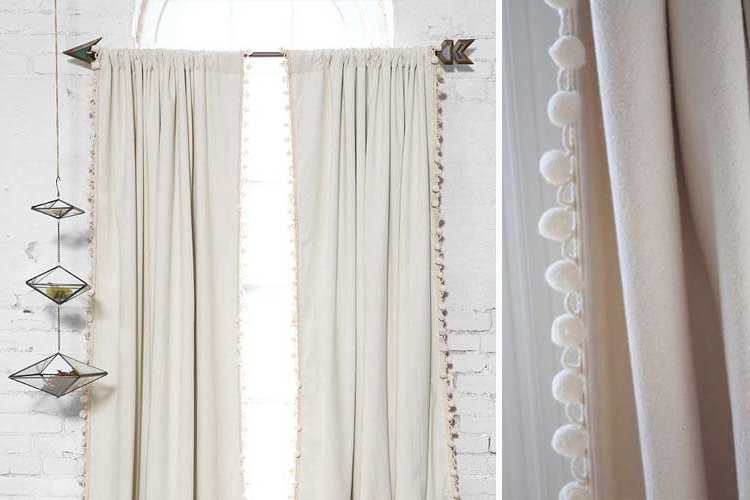

What about complements?
Rustic or sophisticated readaptations of the antique bandeau to hide rails, leather brackets to gather the curtains on the sides, original hanging systems such as branch-shaped rods or ropes as slats are options of accessories to be trendy in curtain decoration.
Bandós

Clamps


Hanging systems


More inspiration...
Doubts? suggestions? any other trends you want to add? While we wait for answers, here are a few more examples of curtain decorating trends to inspire you.


















